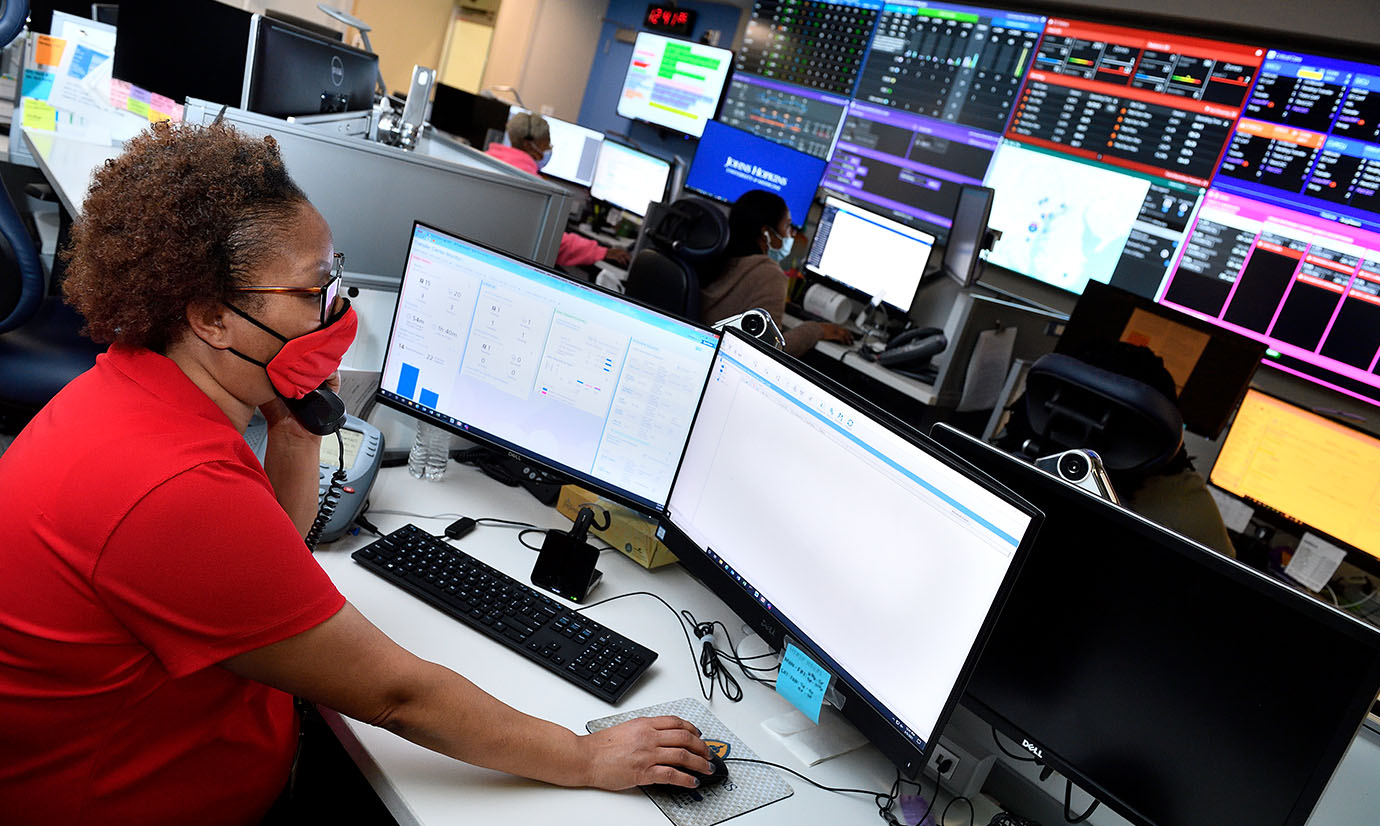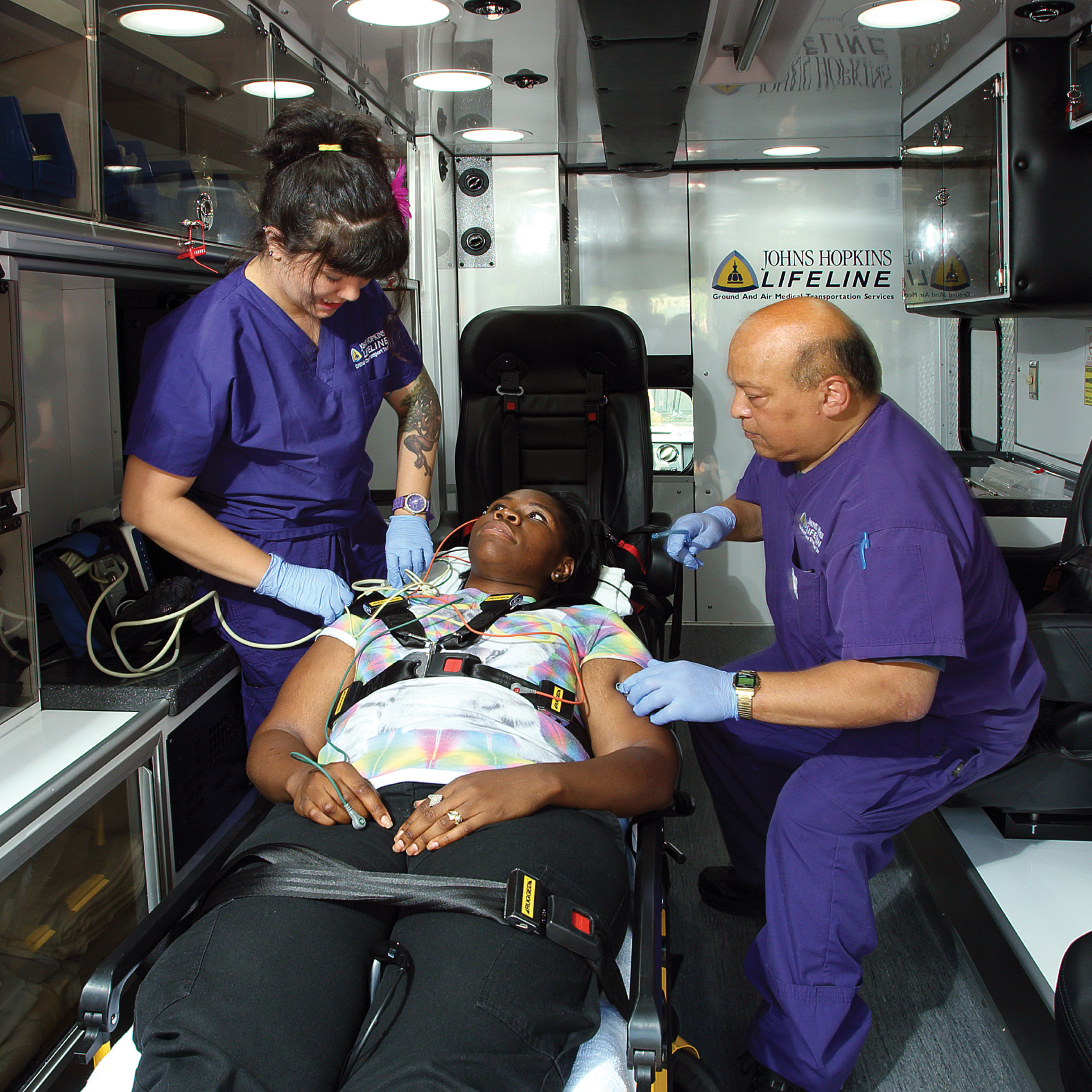One year ago, as Johns Hopkins Medicine prepared for an indefinite surge of highly infectious patients with COVID-19, institutional leaders and clinicians worried about the course of the disease, treatment options, crucial supply chain shortages — and about safety, for patients and staff.
They had seen news reports and heard horror stories from colleagues across the country about emergency departments and intensive care units (ICUs) overwhelmed with very sick patients. Could they manage a sudden, massive and prolonged spike in patient admissions?
On that question, at least, Johns Hopkins offered immediate reassurance.
The Judy Reitz Capacity Command Center, which celebrated its fifth anniversary in January, was created to manage the flow of patients — in periods of crisis as well as normal times. Its staff members control the bed assignments for all patients within The Johns Hopkins Hospital, as well as those transferred to and from four Johns Hopkins Medicine member hospitals: Howard County General, Johns Hopkins Bayview Medical Center, Sibley Memorial and Suburban. The staff also manages patients transferred from outside institutions and physicians.
“We didn’t need a separate plan for patients with COVID-19 because this is what we do every day,” recalls Jim Scheulen, chief administrative officer, emergency medicine and capacity management at Johns Hopkins Medicine. “These were patients with emergency needs just like others, but they had COVID-19. They’re patients and they’re being transported, and we know how to do that.”
However, back in 2016, The Johns Hopkins Hospital, like many hospitals across the country, was suffering serious operational challenges. Backlogs and bottlenecks were clogging the system. Patients lay on gurneys in emergency department hallways because beds were not available on medical units. Operating rooms held back finished cases because there were no open beds. Referring physicians sent patients to other hospitals because Johns Hopkins couldn’t get them in for treatment fast enough. The source of these problems had become clear. Staff members responsible for patient throughput (tracking each patient from admission to discharge) were scattered and often did not speak face to face or in real time.
Creating a New Center of Gravity
Today, between 25 and 30 staff members representing four distinct units sit at workstations that encourage collaboration and communication. The Hopkins Access Line (HAL) team fields phone calls from referring physicians and institutions seeking to get patients admitted for specialized care. Nurses focus on getting each patient into a bed on the most appropriate unit. The Lifeline transport staff supervises patient transfers by helicopter and ambulance between Johns Hopkins member hospitals, as well as by foot between units within The Johns Hopkins Hospital. The admitting team manages registration and documentation from admission through to discharge.
Gone are the days of tracking patients with pen and paper, whiteboards and markers. In 2015–16, Johns Hopkins teamed with GE Healthcare to establish this first-of-its-kind capacity command center, which is now an internationally recognized model of excellence, according to Scheulen. Hundreds of institutions have visited the Capacity Command Center, located on the ground floor near the Nelson/Harvey lobby on the East Baltimore campus, to learn from Johns Hopkins’ experience. More than 20 of these visitors went on to develop similar centers, including Duke Health, Yale New Haven Health and HCA Healthcare.
“Johns Hopkins prides itself on sharing its expertise to improve the health of the world,” says Redonda Miller, president of The Johns Hopkins Hospital. “The thing that inspires me most about this team is how they continually strive to improve processes to provide greater efficiency and greater access. They’re not satisfied with their accomplishments, which are many. They want to make things even better — and they are doing that day after day.”
While there is still room for operational improvements — patients still sometimes get held in emergency department hallways, Scheulen admits — the Command Center is by all measures a major success. “We’ve seen significant advancement and met all the targets we initially set,” he says. “Bed utilization has improved from 85% to about 94% today. We’ve essentially opened 16 beds on a daily basis without building a new wing or adding new staff.” These efficiencies contribute an estimated $16 million in annual revenue, says Scheulen.
The Johns Hopkins Capacity Command Center | Enhancing Hospital Operations Since 2016
The Judy Reitz Capacity Command Center, a state-of-the art control center at The Johns Hopkins Hospital, celebrated its fifth anniversary in 2021. Since it opened, the command center has incorporated the latest in system engineering, predictive analytics and innovative problem-solving to better manage patient safety, experience, volume and movement of patients in and out of the hospital and around the Johns Hopkins Health System.
Like Managing Takeoffs and Landings
Hung high on the wall at the front of the Command Center are a dozen extra-large digital screens awash in bright colors. They blink and change datasets tracked in real time as patients are moved to and from units and beds throughout The Johns Hopkins Hospital.
One screen forecasts occupancy rates for beds in the departments of medicine, surgery, neurosurgery, oncology, gynecology and obstetrics. A green light signals open beds, yellow cautions near capacity and red signals stop — the unit is full. Staff members can also see the exact number of beds waiting to be cleaned and prepared for a new patient. Another screen shows the number of surgeries in progress in each operating room — and the anticipated finish times. Another shows incoming patient transfers from Johns Hopkins member hospitals as well as from outside hospitals and institutions.
And one screen shows a live camera view of people seated, standing or pacing in the waiting room of the adult emergency department. “That screen is there to remind all of us, always, that the numbers on these screens represent real people, real patients,” says Scheulen.
The scene is not unlike what one might expect in an air traffic control tower. “The airline industry is trying to get the right plane, to the right gate, at the right time; we are trying to get the right patient, to the right bed, at the right time,” says Anna Ye, assistant administrator for the Office of Capacity Management. “Air traffic control is about getting planes and passengers safely from one airport to another, and we are focused on moving patients safely though our hospitals.”
Since the beginning, the relationship with GE Healthcare brought technological advancements previously unimagined. Artificial intelligence software drills deep into large data streams, including Epic, to predict patient volumes, from next shift to next day to next week, says Ye. This type of forecasting, now crucial to operations, is even more urgent during the pandemic, especially for leaders who manage the crisis through huddle calls supported by this team’s data and staff.

Working Like One System
Barton Leonard, medical director and chair of the Suburban Hospital emergency department, credits the Command Center with supporting member hospitals throughout the pandemic. “They allowed the community hospitals to decompress and keep their doors open for other patients,” says Leonard. “The Command Center managed transfers to and from, and within, the community hospitals so that we were never truly overwhelmed. We were able to figure out who had capacity, who had staffed beds and who didn’t, so we could align resources with demand.”
Just as important as managing patients with COVID-19 has been the ability of the Command Center team to manage the flow of other critical patients throughout the health system. For example, unlike most community hospitals, Suburban is a 24/7 stroke center with thrombectomy capability, meaning its surgical teams can remove blood clots from the brain with quick precision, instead of administering medication to slowly dissolve the clot. “Jim’s team has been crucial in getting these time-sensitive cases to our facility efficiently — whether by air or ground,” says Leonard. He praises HAL staff for playing the lifesaving role of connecting patients at community hospitals — Sibley Memorial and Howard County General included — with the Suburban team.
“Without the Command Center there would surely be more barriers to transport,” says Leonard. “When a patient is identified, HAL staff quickly get all the players on the phone, including the stroke team, the ICU and the ED docs, and coordinate the transfer to Suburban. We’ve truly become a coordinated system like never before.”
From March 12, 2020, through March 1, 2021, the Lifeline staff transported 659 patients with COVID-19 to and from hospitals in the Johns Hopkins Health System, and another 877 patients with COVID-19 were transferred internally at The Johns Hopkins Hospital. To Lifeline’s credit, not a single transmission of COVID-19 from patient to staff is known to have occurred during a transport. In the same period, the Command Center managed 7,529 patient transfers overall.
From his vantage point as executive vice president and chief operating officer for The Johns Hopkins Hospital, Charlie Reuland is fully aware of the systemic improvements the Capacity Command Center has achieved over the past five years. However, what most impresses him about these team members, he is quick to note, is how they help patients.
“Despite the fact that this team is one step removed from direct patient care, they know that they are not removed from the patient,” says Reuland. “They know they are contributing every day to the outcomes for patients. They feel it, they believe it and they know it.”




